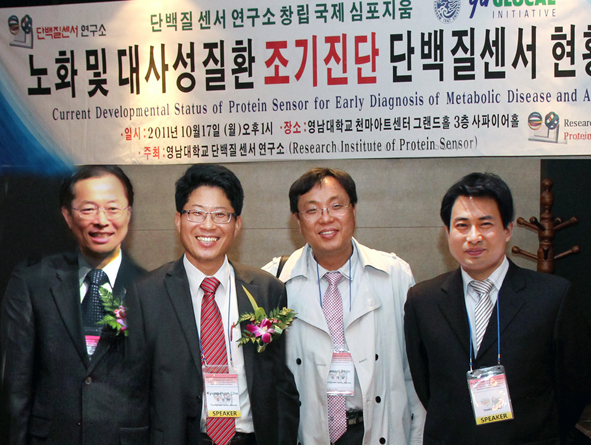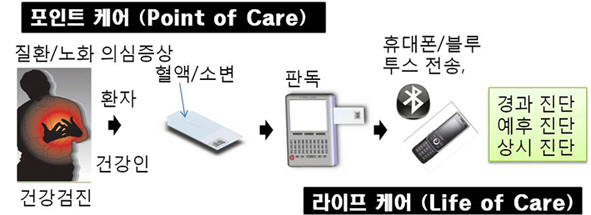“An Era of Self-Diagnosis of Aging Begins!” N
No.88460- Writer YU
- Date : 2012.03.13 17:47
- Views : 10767
Research Institute of Protein Sensor develops convenient ‘chip’ for diagnosing aging.
‘Power of Fusion’ of biotechnology, mechanical engineering, clinical medicine, and basic medicine scientifically proved that severe diabetes makes one look older
[January 4, 2012]
It is probably everybody’s wish to live a long beautiful and healthy life. In order to make this wish come true, one of the most important requisite is to actually measure one’s own aging level, but there are not yet simple and methods to judge one’s level of aging.
However, the first step to make all humankind’s wish come true was taken. The Yeungnam University Research Institute of Protein Sensor (director Cho, Kyung-hyun, Professor at the School of Biotechnology, hereinafter called Research Institute) successfully developed a ‘chip’ to make self-diagnosis using very simple methods.
This was the fruit of bringing down the high walls among the academic fields of biotechnology (Professor Cho, Kyung-hyun), mechanical engineering (Professors Shim, Jae-sool & Lee, Dong-yeon), and medicine (Professor Kim, Jae-ryong, director of the Yeungnam University Aging-associated Vascular Disease Research Center), and has much more meaning because it well exhibited the ‘Power of Fusion Research’.

Professors participating in Protein Sensor Research (from left to right: Professors Kim, Jae-ryong, Cho, Kyung-hyun, Shim, Jae-sool, Lee, Dong-yeon)
The Research Institute has observed the changes of high density lipoprotein (HDL)¹ in the serum of the aged and the young for the past three years. The research revealed that the protein declined with aging, causing it to ‘break’, and that its quantity of electric charge changed. They also proved that because of such structural and functional difference, the mobility of protein by the electric response on ‘lab-on-a-chip’² is different depending on the level of aging. In other words, while the protein of the young serum had short and clear movement bands (meaning that the protein is preserved in its original state), the protein of the aged serum had long and vague movement bands (the protein has severe damages and no energy).
(※See illustration below)
According to the Research Institute, by using this technology, it will become easy not only to check the aging level at home or hospitals with a coin-sized diagnosis chip (square shaped figure below the coin in the above illustration), but also to perform self-diagnosis on risk levels of diabetes and arteriosclerosis.
In addition, the Research Institute also revealed that protein of the aged serum and protein transformed by fructose had common characteristics and mobility. This can be said to scientifically prove the saying that ‘severe diabetes will make one look old’ even if that person is young.
The results of this research were published in the SCI international academic journal ≪Electrophoresis≫, which is ranked in the top 10 in its respective field, in December. Also, over 10 theses on preceding studies were published in the prominent international journals, such as the ≪Gerontological Society of America≫ in 2010 and 2011. Meanwhile, the National Research Foundation of Korea selected this as an excellent research project.
On this, Professor Cho, Kyung-hyun (44, School of Biotechnology), who is also the director of the Yeungnam University Research Institute of Protein Sensor, stated, “In order to procure technologies to apply clinically in large scale, we must first construct a mass production system for the diagnosis chip and also procure additional data in clinical application. For this, we are planning to continue to pursue joint research in which universities are responsible for basic research, corporations are in charge of mass production of diagnosis chips, and large general hospitals conduct clinical applications.”
Meanwhile, the Research Institute of Protein Sensor was established at Yeungnam University in February of last year in order to develop bio sensors and diagnostic systems for early detection of aging of blood vessels through the fusion of different disciplines such as biotechnology, mechanical engineering, clinical medicine, chemistry, pharmacy, and information & communication engineering. It is working hard to achieve its goal of commercializing early detection kits for blood vessel aging, diabetes, obesity, and coronary artery diseases.

1) High Density Lipoprotein (HDL): As a type of serum soluble protein, it combines with cholesterol and sends it to different parts of the body. HDL cholesterol, which is known as ‘good cholesterol’, is the total of vale of HDL and HDL-combined-cholesterol, and the higher it is, the better.
2) Lab-on-a-chip: This is a chemical microprocessor integrated various devices needed for analysis using micro machining technologies. Just as in its name, it means that a ‘lab was placed on top of a chip’. It uses plastic or glass materials and can test very small samples through its tiny channels under nano (1/1,000,000,000) liters. This is a core platform technology that can be used not only for searching for new medicines by pharmaceutical companies, but also applied in various fields such as medical diagnosis equipment, health examination instruments at home and on sickbeds, chemical or bio process monitoring, mobile environmental pollutant analysis instrument, remote chemical/bio agent detection devices for chemical, biological and radioactive environments.